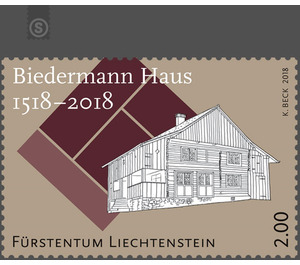500 Years of the Biedermann House - Liechtenstein 2018 - 200 Rappen
Theme: Architecture
| Country | Liechtenstein |
| Issue Date | 2018 |
| Face Value | 200.00 |
| Perforation | 13 1/4 x 13 3/4 |
| Printing Type | 4-color offset & embossing |
| Stamp Type | Commemorative |
| Item Type | Stamp |
| SID | 892255 |
| Dimensions | 30.00 x 45.00 |
| In 16 Wishlists | |
The “Biedermann House” (face value: CHF 2.00), named after a family that lived in it from 1814 to 1964, was built 500 years ago in Schellenberg, the smallest municipality in Liechtenstein in terms of size. The construction of the two-storey wooden building made out of square timber from coniferous wood and insulated with lichens and mosses is in keeping with modern Minergie building regulations. At that time the house did not belong to the person who owned the ground that it stood on according to medieval laws, instead it was part of the leaseholder’s chattels. To allow later generations to move it without any drawings, each beam was numbered when the house was built. Over time the house was thus able to be moved within the municipality several times, for the last time in 1992/93 when the Biedermann House was registered as a protected building. Since 1994 this farmhouse has been open to the public as a museum and provides authentic insight into how people lived in Liechtenstein in around 1900. Graphic artist Karin Beck shows the floorplan of the house in the background of the special stamp and a sketch of the house in the foreground, highlighted by embossing. The timber framing marks required for assembly and disassembly are also to be found on the 12-stamp sheet.


